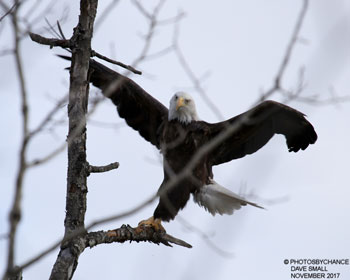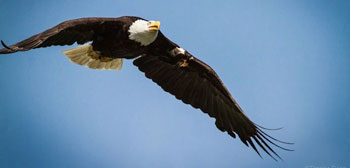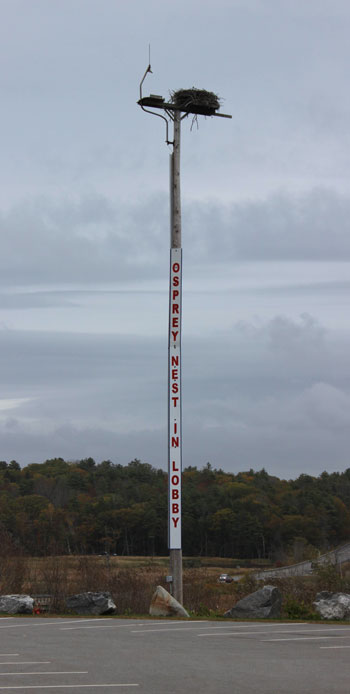Maine’s Bald Eagles
A Great Success Story
by Tom Seymour

The bald eagle, American icon, spectacular bird of prey, target of ranchers, victim of pesticides, saved by public awareness.
The bald eagle, Haliaeetus leucocephalus, found throughout Maine, enchants Mainers and visitors alike. The huge bird (bald eagles have a 7-foot wingspan), with its white head and bright yellow beak, has come to symbolize freedom and rugged independence.
But this wasn’t always so. In the not-too-distant past, eagles were a rarity not only in Maine but along the entire eastern seaboard. The eagle population began a dramatic decline due to the effects of deforestation and spraying of the chemical DDT.
Deforestation occurred through not only commercial cutting of the timber as well as unrestrained shoreline development, but also as a result of the spruce budworm epidemic of the early 1970s. Spruce budworms were responsible for killing countless stands of spruce and balsam fir trees. The antidote of choice back then was chemical spraying with potent chemicals designed to kill the budworms. The chemical arsenal was heavily loaded with DDT and it did its job admirably. The DDT killed budworms, but it had other, more far-reaching consequences.
No Hatchlings
As Maine began winning the war on spruce budworms, it appeared as though the campaign was a success on all fronts. But DDT has a deadly effect upon eagle’s eggs and that wasn’t recognized until it was almost too late. The chemical causes eggshells to become thin and brittle, which led to cracks. The end result was that eagles were no longer able to successfully incubate chicks and the population dwindled as only adults remained.
Toxic DDT and other chemicals entered the ecosystem via runoff to lakes and rivers. Eagles and also, ospreys, that ate fish from contaminated sites were also ingesting DDT. The situation looked bleak when in 1976, it was determined that fewer than 36 individual eagles remained in Maine. What with their DDT-caused inability to hatch their eggs, Maine’s eagles were on their way to extinction.
But a cure had already been undertaken. It would just take some time to work. In 1972, a DDT ban went into effect. The results were not immediate, though, and other measures were undertaken to assist eagles until the time when our water and fish no longer contained DDT.
The Maine Department of Inland Fisheries And Wildlife (DIF&W), buoyed by a grant from the Endangered Species Act, began work aimed at protecting eagle habitat and also, supplying eagles with non-DDT-tainted forage. This came in the form of road-killed deer and other large animals.
Feeding Sites

Something happened and it was mostly due to the new-found sympathy on the part of the public for bald eagles. As of 2017, Maine had 50 nesting pairs of bald eagles. This represents a dramatic increase from the next-to-none status of only 30 years ago. Teresa Bass photo
The idea for enticing to eagles to feed on something other than contaminated fish was a quite literally a bait-and-switch effort. Authorities hoped that if they could get the carrion-eating eagles to begin feeding primarily upon animal carcasses, they would abandon their taste for contaminated fish.
To that end, workers with DIF&W began placing road-killed deer and moose as well as the skinned carcasses of raccoons and beavers supplied by trappers. Many of the sites where these carcasses were deposited became “destination places” for the curious.
The bait-and-switch worked wonderfully and soon, eagles began showing up on the ice at locations where baits were placed. In addition to the non-contaminated food helping eagles to lay eggs that would hatch, the feeding sites became the catalyst for a renewed interest in bald eagles.
As eagles from far and wide discovered the easy sources of food, courtesy of DIF&W, people, too, flocked to the sites in order to observe and photograph eagles. Many of these folks had never seen an eagle until that time.
Eagle recovery took time and by the late 1980s it became clear that recovery efforts were working. It was time, then, to begin work on identifying eagle nesting areas. This was done via aerial surveys.
Since private land in Maine greatly surpasses the amount of public land, most of the eagle nesting sites identified were on private property. So it was necessary for DIF&W personnel to contact and work with private landowners in order to protect eagle nesting habitat.
Bald eagles prefer the wooded shores of both saltwater and freshwater habitats. Such places were at risk from wood cutting and development and as that continued, the fate of our bald eagles was certain to become, once again, quite uncertain.
But something happened and it was mostly due to the new-found sympathy on the part of the public for bald eagles. By now, most everyone was aware of the plight of bald eagles and the majority of landowners voluntarily set out to protect eagle habitat on their land.
It wasn’t only small woodlot owners who pitched in to preserve eagle nesting habitat. Moosehorn National Wildlife Refuge, The Nature Conservancy and Maine Coast Heritage Trust all became willing stewards of eagle nesting habitat. Commercial woodland owners, too, did their part. Commercial woodland owners such as International Paper, Plum Creek Timber and Irving Pulp and Paper developed conservation easements designed to protect nesting eagles. The land trust network developed by the paper companies covered 700,000 acres of protected habitat.
Current Status

Osprey nest on pole in Taste of Maine restaurant parking lot U.S. Route 1, Woolwich, Maine 2017. The restaurant owner, recognizing the area’s habitat, installed the pole in 1999 to attract nesting osprey. The missing sign panel read “view.” Fishermen’s Voice photo
Maine’s DIF&W monitors eagle progress and keeps track of nesting sites. Currently, the Maine bald eagle population is increasing by 7 percent annually. Eagles are now established in all of Maine’s 16 counties.
Maine’s bald eagles were removed from the list of threatened species in 2009. As of 2017, Maine had 50 nesting pairs of bald eagles. This represents a dramatic increase from the next-to-none status of only 30 years ago. In a nutshell, bald eagles are doing well and their status is constantly improving.
Here’s another consideration regarding Maine’s bald eagles and their amazing comeback. What affects eagles also effects humans. The same rivers, lakes and streams where eagles soar in search of prey also attract people. And the fish that were once off-limits for human consumption have become healthy once again.
Besides that, every square foot of land saved from destruction due to development because of nesting eagles is another square foot of land that we and future generations can continue to appreciate for its wild beauty. Once a place is gone it is gone forever and thanks to the bald eagle restoration campaign, Maine now has many acres of prime shoreland frontage that is off the market for good.
And now, as lobster fishermen head out at dawn to tend their traps, many are met with the welcome sight of bald eagles sitting atop tall pines or soaring in the sky. Hikers and campers have the same opportunity to spy bald eagles in flight. And even motorists have every chance to witness the stirring spectacle of mature bald eagles in flight.
Once, when someone spotted a bald eagle, they would become greatly excited, and rightly so. Now, while we still appreciate the sight, it has become commonplace to the extent that we don’t consider an eagle sighting a great event because it happens all the time. And that’s the way it should be.
The bald eagle restoration program stands as one of the most successful efforts ever. While the battle isn’t yet completely won, victory now is a forgone conclusion.
So the next time you see a bald eagle, stop and consider what it took for that bird to even exist, and give silent thanks to all those dedicated individuals who made it happen.
